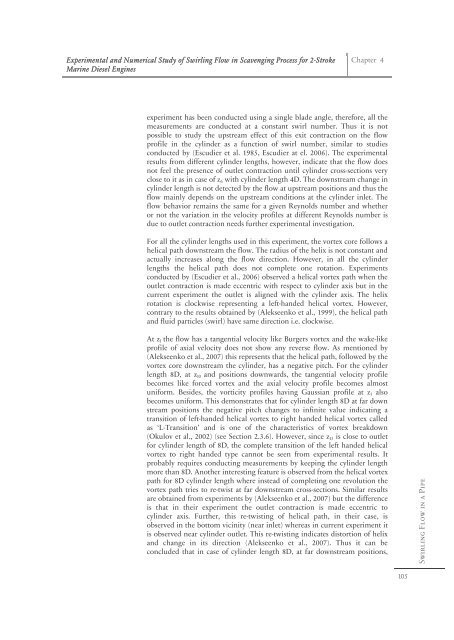Experimental and Numerical Study of Swirling ... - Solid Mechanics
Experimental and Numerical Study of Swirling ... - Solid Mechanics
Experimental and Numerical Study of Swirling ... - Solid Mechanics
Create successful ePaper yourself
Turn your PDF publications into a flip-book with our unique Google optimized e-Paper software.
<strong>Experimental</strong> <strong>and</strong> <strong>Numerical</strong> <strong>Study</strong> <strong>of</strong> <strong>Swirling</strong> Flow in Scavenging Process for 2-Stroke<br />
Marine Diesel Engines<br />
Chapter 4<br />
experiment has been conducted using a single blade angle, therefore, all the<br />
measurements are conducted at a constant swirl number. Thus it is not<br />
possible to study the upstream effect <strong>of</strong> this exit contraction on the flow<br />
pr<strong>of</strong>ile in the cylinder as a function <strong>of</strong> swirl number, similar to studies<br />
conducted by (Escudier et al. 1985, Escudier at el. 2006). The experimental<br />
results from different cylinder lengths, however, indicate that the flow does<br />
not feel the presence <strong>of</strong> outlet contraction until cylinder cross-sections very<br />
close to it as in case <strong>of</strong> z6 with cylinder length 4D. The downstream change in<br />
cylinder length is not detected by the flow at upstream positions <strong>and</strong> thus the<br />
flow mainly depends on the upstream conditions at the cylinder inlet. The<br />
flow behavior remains the same for a given Reynolds number <strong>and</strong> whether<br />
or not the variation in the velocity pr<strong>of</strong>iles at different Reynolds number is<br />
due to outlet contraction needs further experimental investigation.<br />
For all the cylinder lengths used in this experiment, the vortex core follows a<br />
helical path downstream the flow. The radius <strong>of</strong> the helix is not constant <strong>and</strong><br />
actually increases along the flow direction. However, in all the cylinder<br />
lengths the helical path does not complete one rotation. Experiments<br />
conducted by (Escudier et al., 2006) observed a helical vortex path when the<br />
outlet contraction is made eccentric with respect to cylinder axis but in the<br />
current experiment the outlet is aligned with the cylinder axis. The helix<br />
rotation is clockwise representing a left-h<strong>and</strong>ed helical vortex. However,<br />
contrary to the results obtained by (Alekseenko et al., 1999), the helical path<br />
<strong>and</strong> fluid particles (swirl) have same direction i.e. clockwise.<br />
At z1 the flow has a tangential velocity like Burgers vortex <strong>and</strong> the wake-like<br />
pr<strong>of</strong>ile <strong>of</strong> axial velocity does not show any reverse flow. As mentioned by<br />
(Alekseenko et al., 2007) this represents that the helical path, followed by the<br />
vortex core downstream the cylinder, has a negative pitch. For the cylinder<br />
length 8D, at z10 <strong>and</strong> positions downwards, the tangential velocity pr<strong>of</strong>ile<br />
becomes like forced vortex <strong>and</strong> the axial velocity pr<strong>of</strong>ile becomes almost<br />
uniform. Besides, the vorticity pr<strong>of</strong>iles having Gaussian pr<strong>of</strong>ile at z1 also<br />
becomes uniform. This demonstrates that for cylinder length 8D at far down<br />
stream positions the negative pitch changes to infinite value indicating a<br />
transition <strong>of</strong> left-h<strong>and</strong>ed helical vortex to right h<strong>and</strong>ed helical vortex called<br />
as ‘L-Transition’ <strong>and</strong> is one <strong>of</strong> the characteristics <strong>of</strong> vortex breakdown<br />
(Okulov et al., 2002) (see Section 2.3.6). However, since z13 is close to outlet<br />
for cylinder length <strong>of</strong> 8D, the complete transition <strong>of</strong> the left h<strong>and</strong>ed helical<br />
vortex to right h<strong>and</strong>ed type cannot be seen from experimental results. It<br />
probably requires conducting measurements by keeping the cylinder length<br />
more than 8D. Another interesting feature is observed from the helical vortex<br />
path for 8D cylinder length where instead <strong>of</strong> completing one revolution the<br />
vortex path tries to re-twist at far downstream cross-sections. Similar results<br />
are obtained from experiments by (Alekseenko et al., 2007) but the difference<br />
is that in their experiment the outlet contraction is made eccentric to<br />
cylinder axis. Further, this re-twisting <strong>of</strong> helical path, in their case, is<br />
observed in the bottom vicinity (near inlet) whereas in current experiment it<br />
is observed near cylinder outlet. This re-twisting indicates distortion <strong>of</strong> helix<br />
<strong>and</strong> change in its direction (Alekseenko et al., 2007). Thus it can be<br />
concluded that in case <strong>of</strong> cylinder length 8D, at far downstream positions,<br />
105<br />
<strong>Swirling</strong> Flow in a Pipe
















